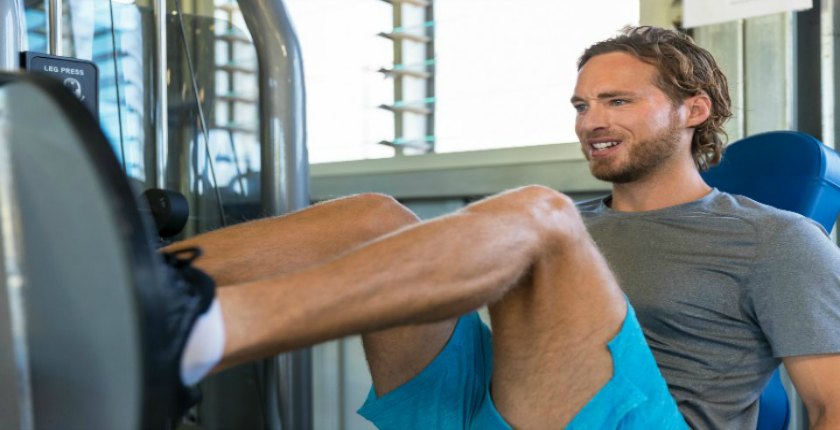Injury Information
Hamstring strain – A guide to prevention and management
- March 16, 2017
- Posted by: Epworth Website

One of the most common injuries in sport is the hamstring strain, as the hamstring muscles are very susceptible to tears and strains. Hamstring strains are most common among sports that require a high degree of speed, power and agility such as soccer, basketball, tennis and football.
Anatomy
The hamstring group of muscles, located on the back of the upper leg, are a group of three separate muscles: Biceps Femoris, Semimembranosus and Semitendinosus. The top of these muscles are attached to the lower part of the pelvis, and the bottom of the hamstring muscles are attached to the tibia and fibula (shin bones) just below the knee joint. The action of the hamstring muscles is to flex (bend) the knee and extend (straighten) the hip.
Risk
The major cause of hamstring injuries originates from an imbalance between the quadriceps muscle and the hamstring muscles (located at the front and back of the thigh respectively). The quadriceps are a very large, strong group of muscles which help to extend (straighten) the leg. These muscles may forcibly overstretch the hamstring, placing excessive tension on the hamstring muscles.
Acute hamstring strains occur due to a sudden movement or force being applied to the hamstring muscles. The player is immediately aware of the condition. Sometimes players hear an audible pop.
Proven risk factors:
- Previous hamstring injury
- Increasing age of player
- Sudden change in direction (acceleration or deceleration).
- Suspected risk factors:
- Poor flexibility
- Poor strength
- Hamstring muscle fatigue
- Muscle strength imbalance between the quadriceps and hamstrings
- Inappropriate, inadequate or no warm up.
Prevention
- Completing a thorough general body warm up, which includes sport-specific muscle stretching as well as sport specific skill drills.
- Including appropriate speed work in training programs so the hamstring muscles are capable of sustaining high acceleration forces.
- Maintaining high levels of cardiovascular fitness and muscular endurance to prevent fatigue.
- Stretching and cooling down after every training session and competition.
- Including stretching and strengthening exercises in weekly training programs.
- Undertaking training prior to competition to ensure readiness to play.
- Gradually increasing the intensity and duration of training.
- Allowing adequate recovery time between workouts or training sessions.
- Wearing the right protective equipment including footwear.
- Checking the sporting environment for hazards.
- Drinking water before, during and after play.
- Avoiding activities that cause pain. If pain does occur, discontinuing the activity immediately and commencing RICER.
Signs and Symptoms
Hamstring strains are classified as Grade 1 – 3 strains depending on severity. A hamstring strain may occur in one or more of the three muscles in the group.
Grade 1 (Mild)
- Overstretching without tearing of muscle or tendon fibres.
- Symptoms may not present until activity is over.
- Usually no loss of muscular strength or flexibility.
- Increased tightness in the muscle during stretch or through a full range of motion.
- A feeling of pain may be reported with sitting or while walking uphill or ascending stairs.
- Depending on the severity, weight bearing activities may or may not be possible, walking properly may be possible and there will be minimal swelling.
Grade 2 (Moderate)
- Partial tear in the muscle.
- Muscular strength and flexibility is reduced.
- Pain is more immediate and more severe than the pain of a Grade 1 strain.
- Pain on stretch and contraction of the muscle, and is usually sore to touch.
- Limping is likely during walking and occasional sudden twinges of pain during activity may occur.
- Bending the knee against resistance will cause pain and there may be some difficulty in fully straightening the knee.
Grade 3 (Severe)
- Severe or complete rupture of the muscle.
- May be a large lump (of muscle tissue) above a depression where the tear is.
- Sudden, sharp pain in the back of the thigh.
- Walking is not possible without pain.
- After a few days with Grade 2 and 3 injuries, a large bruise may appear below the injury site caused by bleeding within the tissues.
- May require surgical repair.
Immediate management
The immediate treatment of any soft tissue injury consists of the RICER protocol – rest, ice, compression, elevation and referral. RICE protocol should be followed for 48-72 hours. The aim is to reduce the bleeding and damage in the muscle. The muscle should be rested in an elevated position with an ice pack applied for 20 minutes every two hours (never apply ice directly to the skin). A correctly sized compression bandage should be applied to limit bleeding and swelling in the injured area.
The No HARM protocol should also be applied – no heat, no alcohol, no running or activity and no massage. This will ensure decreased bleeding and swelling in the injured area.
Rehabilitation and return to play
Time frames for rehabilitation and return to sport vary depending on the nature and severity of the strain. As a general rule, Grade 1 hamstring strains should be rested from sporting activity for about three weeks and Grade 2 injuries for a minimum of four to eight weeks. In the case of a complete rupture (Grade 3 strain), the muscle may have to be repaired surgically and the rehabilitation to follow will take about three months.
Premature return to sport and inadequate rehabilitation will increase the risk of re-injury. Full stretch and strength should be achieved in addition to the ability to perform full speed training. Assessment of sport-related activities, such as twisting, jumping and changing direction suddenly should also be evaluated.
